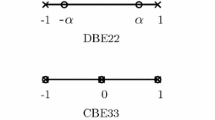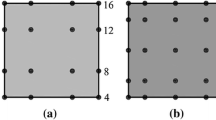Abstract
Sensitivity analysis of coupled acoustic-structural systems under non-stationary random excitations is investigated in this paper. The combined method of direct differentiation method (DDM) and pseudo excitation method (PEM) in previous work is computationally expensive for problems with large-scale design variables. To circumvent this difficulty, a fast sensitivity analysis method integrating the adjoint variable method (AVM) and PEM for coupled acoustic-structural systems under non-stationary random excitations is proposed. In this framework, the sensitivity analysis of coupled systems subject to non-stationary random excitations is transformed into a sensitivity analysis under pseudo-transient excitations with the help of PEM. On this basis, the computing efficiency of random response sensitivity is improved directly by solving the adjoint equations involved in the AVM. Numerical examples fully demonstrate the accuracy and efficiency of the proposed method.












Similar content being viewed by others
References
Cacciola P, Colajanni P, Muscolino G (2005) A modal approach for the evaluation of the response sensitivity of structural systems subjected to non-stationary random processes. Comput Methods Appl Mech Eng 194(42):4344–4361
Chen G, Zhao GZ, Chen BS (2009) Sensitivity analysis of coupled structural-acoustic systems subjected to stochastic excitation. Struct Multidiscip Optim 39(1):105–113. https://doi.org/10.1007/s00158-008-0320-x
Chen L, Marburg S, Chen H, Hao Z, Gao H (2017) An adjoint operator approach for sensitivity analysis of radiated sound power in fully coupled structural-acoustic systems. J Comput Acoust 25(1):1750003
Chen L, Zheng C, Chen H (2014) FEM/wideband FMBEM coupling for structural–acoustic design sensitivity analysis. Comput Methods Appl Mech Eng 276(7):1–19
Choi KK, Shim I, Wang S (1997) Design sensitivity analysis of structure-induced noise and vibration. J Vib Acoust 119(2):173–179
Dammak K, Koubaa S, Hami AE, Walha L, Haddar M (2019) Numerical modelling of vibro-acoustic problem in presence of uncertainty: application to a vehicle cabin. Appl Acoust 144:113–123
Egab L, Wang X (2015) Objective evaluation of interior trim effects on sound quality and noise reduction of a coupled plate cavity system. Mech Syst Signal Process 70:919–931
Greco R, Trentadue F (2013) Structural reliability sensitivities under nonstationary random vibrations. Math Probl Eng 2013(5):301–312
Hasheminejad SM, Shakeri R, Rezaei S (2012) Vibro-acoustic response of an elliptical plate-cavity coupled system to external shock loads. Appl Acoust 73(8):757–769. https://doi.org/10.1016/j.apacoust.2012.02.009
Hu Z, Su C, Chen T, Ma H (2016) An explicit time-domain approach for sensitivity analysis of non-stationary random vibration problems. J Sound Vib 382:122–139. https://doi.org/10.1016/j.jsv.2016.06.034
Kim NH, Dong J (2006) Shape sensitivity analysis of sequential structural-acoustic problems using FEM and BEM. J Sound Vib 290(1):192–208
Li W, Chai YB, Lei M, Liu GR (2014) Analysis of coupled structural-acoustic problems based on the smoothed finite element method (S-FEM). Eng Anal Bound Elem 42:84–91. https://doi.org/10.1016/j.enganabound.2013.08.009
Liu QM (2012) Sensitivity and Hessian matrix analysis of power spectral density functions for uniformly modulated evolutionary random seismic responses. Finite Elem Anal Design 48(1):1370–1375
Liu Z, Majeed M, Cirak F, Simpson RN (2018) Isogeometric FEM-BEM coupled structural-acoustic analysis of shells using subdivision surfaces. Int J Numer Methods Eng 113(9):1507–1530
Luo J, Gea HC (1997) Modal sensitivity analysis of coupled acoustic-structural systems. J Vib Acoust 119(4):545–550
Ma ZD, Hagiwara I (1991a) Improved mode-superposition technique for modal frequency response analysis of coupled acoustic-structural systems. AIAA J 29(10):1720–1726
Ma ZD, Hagiwara I (1991b) Sensitivity analysis methods for coupled acoustic-structural systems part II: direct frequency response and its sensitivities. AIAA J 29(11):1796–1801
Shang L, Zhai J, Zhao G (2020) Stochastic sensitivity analysis of coupled acoustic-structural systems under non-stationary random excitations. J Fluid Struct 97:103093. https://doi.org/10.1016/j.jfluidstructs.2020.103093
Shang L, Zhao G, Zhai J (2017) Topology optimization for coupled acoustic-structural systems under random excitation. Struct Multidiscip Optim 56(4):809–822. https://doi.org/10.1007/s00158-017-1687-3
Wang M, Huang Q (2016) A new hybrid uncertain analysis method for structural-acoustic systems with random and interval parameters. Comput Struct 175:15–28
Xia BZ, Yu DJ (2014) An interval random perturbation method for structural-acoustic system with hybrid uncertain parameters. Int J Numer Methods Eng 97(3):181–206
Xu WT, Zhang YH, Lin JH, Kennedy D, Williams FW (2011) Sensitivity analysis and optimization of vehicle–bridge systems based on combined PEM–PIM strategy. Comput Struct 89(3):339–345
Zhu G, Liu YH (2012) Sensitivity analysis of flow-induced vibration noise from elastic plate with a cavity. Appl Mech Mater 197:246–251
Funding
This research project is supported by the National Natural Science Foundation of China (U1508209, 11072049), Talents Introduction Research Fund of Shenyang Aerospace University (19YB10, 19YB11). The authors would like to acknowledge these funds support.
Author information
Authors and Affiliations
Corresponding author
Ethics declarations
Conflict of interest
The authors declare that they have no conflict of interest.
Replication of results
To facilitate replication of the results, some important MATLAB codes are listed below
Additional information
Responsible Editor: Shikui Chen
Publisher's note
Springer Nature remains neutral with regard to jurisdictional claims in published maps and institutional affiliations.
Appendix
Appendix

Rights and permissions
About this article
Cite this article
Shang, L., Zhai, J. & Zhao, G. Sensitivity analysis of coupled acoustic-structural systems under non-stationary random excitations based on adjoint variable method. Struct Multidisc Optim 64, 3331–3343 (2021). https://doi.org/10.1007/s00158-021-02978-0
Received:
Revised:
Accepted:
Published:
Issue Date:
DOI: https://doi.org/10.1007/s00158-021-02978-0




